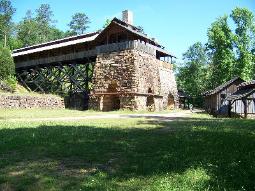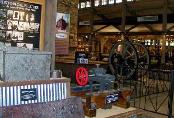Tannehill Ironworks
The historic ironworks date
from the Civil War era and are
a focal point of the park.
The historic ironworks date
from the Civil War era and are
a focal point of the park.
Alabama Scenery
Tannehill Ironworks Historical
State Park also offers a wide
variety of beautiful scenery.
Tannehill Ironworks Historical
State Park also offers a wide
variety of beautiful scenery.
Tannehill Ironworks Historical State Park - McCalla, Alabama
Tannehill Ironworks Historical State Park - McCalla, Alabama
| Tannehill Ironworks Three massive Civil War era blast furnaces have been beautifully restored and can now be explored at Tannehill Ironworks Historical State Park |
Civil War Ironworks in Alabama
Just as it became in later years for the nation
as a whole, the state of Alabama was a vital
center of iron production for the Confederate
states during the Civil War. This industry that
proved so vital to the Southern war effort can
be explored at the remarkable Tannehill
Ironworks Historical State Park.
Located in off Interstate 59 less than 30
minutes from downtown Birmingham,
Tannehill was a major facility for the
production of iron during the Civil War. The
well-preserved site has been beautifully
restored and now is the focal point of a park
that is among the finest in the state.
The production of iron at the site actually
began in 1830 when Daniel Hillman built a
forge on the banks of Roupes Creek. He died
within two years and the facility was taken
over by Ninian Tannehill, who operated it as
a sideline to his more profitable farming
operation.
In 1859, however, the small forge evolved
into something much greater. A slave labor
force began work on the massive Tannehill
No. 1 furnace, designed by ironmaster
Moses Stroup. Over the next four years,
hundreds of slaves hand cut sandstone
blocks and pulled them on skids to the site
for use in the building of three large blast
furnaces.
By 1863, the Tannehill Ironworks could
produce 22 tons of desperately needed iron
per day. Used for the casting of artillery,
cookware and even cast iron stoves for the
Confederate army, the iron produced at
Tannehill contributed significantly to the
Southern war effort. Around 500 workers lived
in cabins on the site and the facility also
included a gristmill, tannery and tax-in-kind
warehouse.
Remarkably, Tannehill operated to within one
week of the surrender of Robert E. Lee. The
death blow to the facility finally came on
March 31, 1865, when it was targeted by the
troops of Union General James Wilson.
As Wilson and his men pushed south
through Alabama, they targeted the iron
facilities throughout the central part of the
state. Three companies from the 8th Iowa
Cavalry seized Tannehill on March 31st and
by the end of the day, the wooden parts of the
facility had been reduced to ashes and the
massive stone furnaces were no longer
operational.
From the ironworks at Tannehill, the Union
raiders pushed south to strike the Bibb Naval
Furnaces at today's Brierfield Ironworks
Historical State Park. Wilson ultimately fought
famed Confederate general Nathan Bedford
Forrest at the Battle of Ebenezer Church and
Battle of Selma before turning east to capture
Montgomery.
The destruction of the Alabama ironworks
came too late in the Civil War to have any real
impact on the outcome of the conflict. The
damage done to the facilities did, however,
further damage the economy of Alabama and
cause even more hardship for the Southern
people in the years after the war.
Enough bits and pieces were reassembled
at Tannehill after Wilson's Raid to keep a
small furnace in operation until 1867. An
attempt to rebuild the ironworks failed in
1868 and Tannehill was abandoned. Nature
then reclaimed its own, preserving in the
process a remarkable Civil War facility.
as a whole, the state of Alabama was a vital
center of iron production for the Confederate
states during the Civil War. This industry that
proved so vital to the Southern war effort can
be explored at the remarkable Tannehill
Ironworks Historical State Park.
Located in off Interstate 59 less than 30
minutes from downtown Birmingham,
Tannehill was a major facility for the
production of iron during the Civil War. The
well-preserved site has been beautifully
restored and now is the focal point of a park
that is among the finest in the state.
The production of iron at the site actually
began in 1830 when Daniel Hillman built a
forge on the banks of Roupes Creek. He died
within two years and the facility was taken
over by Ninian Tannehill, who operated it as
a sideline to his more profitable farming
operation.
In 1859, however, the small forge evolved
into something much greater. A slave labor
force began work on the massive Tannehill
No. 1 furnace, designed by ironmaster
Moses Stroup. Over the next four years,
hundreds of slaves hand cut sandstone
blocks and pulled them on skids to the site
for use in the building of three large blast
furnaces.
By 1863, the Tannehill Ironworks could
produce 22 tons of desperately needed iron
per day. Used for the casting of artillery,
cookware and even cast iron stoves for the
Confederate army, the iron produced at
Tannehill contributed significantly to the
Southern war effort. Around 500 workers lived
in cabins on the site and the facility also
included a gristmill, tannery and tax-in-kind
warehouse.
Remarkably, Tannehill operated to within one
week of the surrender of Robert E. Lee. The
death blow to the facility finally came on
March 31, 1865, when it was targeted by the
troops of Union General James Wilson.
As Wilson and his men pushed south
through Alabama, they targeted the iron
facilities throughout the central part of the
state. Three companies from the 8th Iowa
Cavalry seized Tannehill on March 31st and
by the end of the day, the wooden parts of the
facility had been reduced to ashes and the
massive stone furnaces were no longer
operational.
From the ironworks at Tannehill, the Union
raiders pushed south to strike the Bibb Naval
Furnaces at today's Brierfield Ironworks
Historical State Park. Wilson ultimately fought
famed Confederate general Nathan Bedford
Forrest at the Battle of Ebenezer Church and
Battle of Selma before turning east to capture
Montgomery.
The destruction of the Alabama ironworks
came too late in the Civil War to have any real
impact on the outcome of the conflict. The
damage done to the facilities did, however,
further damage the economy of Alabama and
cause even more hardship for the Southern
people in the years after the war.
Enough bits and pieces were reassembled
at Tannehill after Wilson's Raid to keep a
small furnace in operation until 1867. An
attempt to rebuild the ironworks failed in
1868 and Tannehill was abandoned. Nature
then reclaimed its own, preserving in the
process a remarkable Civil War facility.
Now the centerpiece of the beautiful 1,500
acre Tannehill Ironworks Historical State
Park, the ironworks have been restored. They
offer visitors a unique chance to step back in
time to learn about the industrial side of the
Confederate war effort.
Including the ironworks, the park preserves
dozens of historical structures. Among these
are a working gristmill, cotton gin, pioneer
farm and more. A major center for heritage
crafts, Tannehill hosts "Trade Days" on the
third weekend of each month from March -
November.
Other annual events include a Dulcimer
Festival, Civil War Reenactment, Halloween
Festival and more. Click here for complete
event information.
The park is home to the outstanding
Alabama Iron and Steel Museum. There you
can learn about the history of iron and steel
in Alabama and see actual artifacts produced
using Tannehill iron.
Tannehill also offers hiking trails, picnic
areas, campgrounds, cabins, a restaurant,
miniature train and much more. Please click
here to visit their official website for more
information.
Tannehill Ironworks Historical State Park is
easy to access via either Exit 100 from
Interstate 59 or Exit 1 from Interstate 459. The
address is 12632 Confederate Parkway;
McCalla, Alabama.
The park is open daily. Admission is $3 for
adults, $2 for Seniors (age 62 and older) and
$1 for kids ages 6-11. Children 5 and under
are admitted free.
While visiting Tannehill, be sure to see the
Sadler Plantation House just outside the
park. Its original portions date from 1817 and
the house is a fine example of an early
Alabama plantation home.
acre Tannehill Ironworks Historical State
Park, the ironworks have been restored. They
offer visitors a unique chance to step back in
time to learn about the industrial side of the
Confederate war effort.
Including the ironworks, the park preserves
dozens of historical structures. Among these
are a working gristmill, cotton gin, pioneer
farm and more. A major center for heritage
crafts, Tannehill hosts "Trade Days" on the
third weekend of each month from March -
November.
Other annual events include a Dulcimer
Festival, Civil War Reenactment, Halloween
Festival and more. Click here for complete
event information.
The park is home to the outstanding
Alabama Iron and Steel Museum. There you
can learn about the history of iron and steel
in Alabama and see actual artifacts produced
using Tannehill iron.
Tannehill also offers hiking trails, picnic
areas, campgrounds, cabins, a restaurant,
miniature train and much more. Please click
here to visit their official website for more
information.
Tannehill Ironworks Historical State Park is
easy to access via either Exit 100 from
Interstate 59 or Exit 1 from Interstate 459. The
address is 12632 Confederate Parkway;
McCalla, Alabama.
The park is open daily. Admission is $3 for
adults, $2 for Seniors (age 62 and older) and
$1 for kids ages 6-11. Children 5 and under
are admitted free.
While visiting Tannehill, be sure to see the
Sadler Plantation House just outside the
park. Its original portions date from 1817 and
the house is a fine example of an early
Alabama plantation home.
A Civil War Landmark
Tannehill was broken up by
Union soldiers near the end
of the Civil War.
Tannehill was broken up by
Union soldiers near the end
of the Civil War.
Online Tour of Tannehill Ironworks Park
Alabama Iron and Steel Museum
Historic Sadler Plantation House
Wilson's Raid, 1865
Brierfield Ironworks Historical State Park
Birmingham, Alabama
Historic Sites & Points of Interest
Historic Sites in Alabama
Explore other Southern Historic Sites
Alabama Iron and Steel Museum
Historic Sadler Plantation House
Wilson's Raid, 1865
Brierfield Ironworks Historical State Park
Birmingham, Alabama
Historic Sites & Points of Interest
Historic Sites in Alabama
Explore other Southern Historic Sites



Iron and Steel Museum
Tannehill is also home to the
Alabama Iron and Steel
Museum. It interprets the
history of the state's famed
iron and steel industry.
Tannehill is also home to the
Alabama Iron and Steel
Museum. It interprets the
history of the state's famed
iron and steel industry.

| Photos of Tannehill by Lauren McCormick |
| Copyright 2011 & 2014 by Dale Cox All rights reserved. Last Updated: March 30, 2014 |

Wilson's Raid of 1865
The ironworks were targeted
by the 8th Iowa Cavalry during
Wilson's Raid of 1865, one of
the last major cavalry raids of
the Civil War.
The ironworks were targeted
by the 8th Iowa Cavalry during
Wilson's Raid of 1865, one of
the last major cavalry raids of
the Civil War.
Battle of Columbus, GA (Girard, AL)
Battle of Ebenezer Church
Battle of Mobile Bay
Battle of Selma
Historic Blakeley State Park
Fort Gaines Historic Site
Fort Morgan State Historic Site
Battle of Ebenezer Church
Battle of Mobile Bay
Battle of Selma
Historic Blakeley State Park
Fort Gaines Historic Site
Fort Morgan State Historic Site

Custom Search
Civil War in Alabama
Video Tour of Tannehill Ironworks

